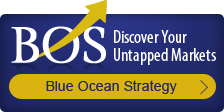
Blue Ocean Strategy Tools: The Four Actions Framework and ERRC Grid
After you define the three tiers of non customers, the idea is that you poll these noncustomers and find out what it would take to purchase your product or service. For example, Nintendo asked people in their three tiers why they didn’t play games. Then they asked what would entice them to play. They took the answers to those questions and designed the Nintendo Wii. It has been a huge hit, attracting noncustomers who never before played electronic games.
The typical electronic game was very high tech and difficult to learn, which thrilled the young antisocial males in that market, but turned everyone else off. The average person wanted something easy to learn and have fun with. Looking at the competitive factors researched for electronic games (see Creating Your Strategy Canvas, May 11, 2009), we find out the following regarding the noncustomers we researched from the Three Tiers:
1. They thought the price was high, preferring something more affordable
2. They like the graphics but the very high resolution wasn’t necessary
3. The number of games was still important for variety
4. The online play wasn’t so important
5. They disliked the complexity, wanting something much simpler
6. The console specifications didn’t need to be so broad making the console difficult to learn
7. They wanted the additional feature of activity
8. They wanted the additional feature of being easy to use
OK, so what do we do with this information? When you look at the competitive factors, there are really only four actions you can take with them. You can eliminate them completely, you can reduce your investment in them, you can raise your investment in them or you can create totally new factors. These four actions then are the basis for creating a new strategy canvas. Here is a picture of the concept:
To help you keep track of your competitive factors and see what you are doing, the Eliminate-Reduce-Raise-Create Grid (ERRC) keeps the factors sorted:
Once you have this information, now you can recreate your value curve on the strategy canvas.
See how different the Red Ocean and Blue Ocean Value Curves are? These represent both the old (Red Ocean) and new (Blue Ocean) value propositions to the customers. It is easy to see the difference and to show this to the entire company from senior managers to janitorial staff and have them understand how the company or product will be different.
Email me now (info@corporatestrategy.com) for further instructions on how to use the Four Actions Framework and ERRC grid or to request information regarding our speaking and consulting services. See our website http://www.corporatestrategy.com/























1 Responses to Blue Ocean Strategy Tools: The Four Actions Framework and ERRC Grid
Is there any analytical model that represent the four actions framework of BOS that makes easier to choose what product’s variable that have to E/R/R/C ? thanks,